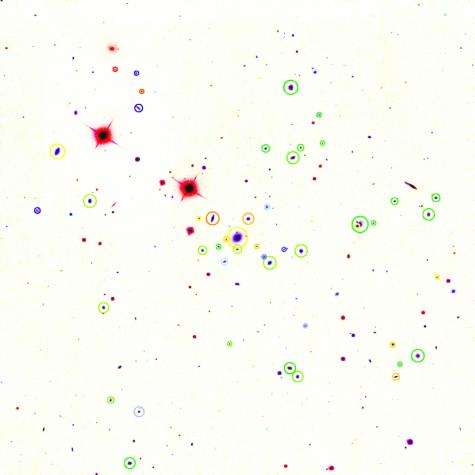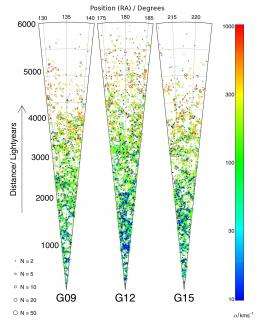Astronomers peer into the dark

(PhysOrg.com) -- Astronomers from the Scottish Universities Physics Alliance (SUPA) have produced a completely new catalogue of ~15,000 groups of galaxies that gives a new insight into dark matter, the material of unknown composition that makes up a fifth of the mass of the Universe. Dr. Aaron Robotham of the University of St Andrews will present the work of the Galaxy and Mass Assembly (GAMA) team in his talk on Thursday 21 April at the Royal Astronomical Society's National Astronomy Meeting in Llandudno, Wales.
Current models of the Universe predict that galaxies reside in large clumps of dark matter, commonly referred to as dark matter halos. Unlike individual galaxies, galaxy groups provide a unique environment in which to study the properties of this elusive material. Understanding the 20% of the cosmos comprised of dark matter is important – in comparison only 3% of the mass of Universe consists of 'ordinary' matter.
"The motions of the galaxies inside the groups provide a direct method for studying the properties of dark matter", says Dr Aaron Robotham who leads the group catalogue project. "Studying dark matter in galaxies is confused by normal processes such as star formation, while this unseen material dominates the motions of galaxies in groups."
Dr. Robotham describes the construction of the group catalogue, which is a significant improvement on previous similar attempts with much shallower surveys. "The sample has some of the most massive bound structures ever measured. These range from the equivalent of a million billion times the mass of the Sun down to a mere few thousand billion solar masses. To have this range of dark matter halo masses within a single study is unprecedented."

"Some of our groups contain hundreds of galaxies while others only a handful", says Dr. Peder Norberg, a co-investigator based at the Royal Observatory Edinburgh, "the ratio of the number of very high mass to very low mass groups is a direct indicator of the type of dark matter that the Universe contains. Hot or warm dark matter (meaning light particles) suppresses the formation of low mass halos while cold dark matter (heavy particles) encourages their formation."
It will take a further few years of detailed studies, with a large range of models, before a definite conclusion can be reached on whether the new GAMA data and supercomputer predictions (based on the popular Cold Dark Matter model of the Universe) are in good agreement or not.
"Currently the differences seen between the model and the data can be understood as limitations in the galaxy formation model used, explaining why intense modelling and further studies are required, and hopefully leading to some exciting new findings in the years ahead with possibly the first new insight into the properties of dark matter particles," adds Dr. Norberg.
GAMA team leader Professor Simon Driver of the University of St Andrews and the International Centre for Radio Astronomy Research at the University of Western Australia, says this group catalogue is the first big step of 4 years of data gathering by the GAMA Team at the Anglo-Australian Telescope. "The catalogue will provide the opportunity to study how gravity works over an unprecedented mass range and using data from other telescopes around the world we will shed fresh light on how dark mater helps to turn gas into stars".
Provided by Royal Astronomical Society




















